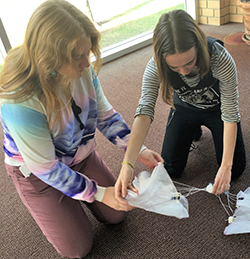The golf balls that Bill Trapp’s students launched over a third-story railing could be the basis for future engineering or science innovations.
More than 50 students, mostly seniors, in Trapp’s advanced projects in physics and engineering class worked in pairs or threesomes for about two weeks to study and practice with forces that relate to falling combined with air resistance.

Teams were given a limited amount of material to design, pack and deploy their plastic-bag chutes. The goal: to keep a golf ball aloft for at least six seconds during a 20- to 30-foot fall from the balcony of the Performing Arts Center.
An average of six over three drops meant an A on the project.
If confidence was any indicator, Nick Milanowski, Ryan Eardley and Bryan Clahassey were shoe-ins with their simple, single-chute design that connected the strings directly to the ball.
“We’re getting the school record,” Nick said.
Nearby, C.J. Edgerle and Mica Walter-Rooks worked to pack two smaller chutes inside a modified plastic bottle whose weight was meant to facilitate deployment.

Their thoughts? “I’m confident it will float,” Mica said. “For six seconds? Not so sure.”
Trapp said the four-year-old class is geared to those who are considering studying engineering or design in college. Students in the class do two large-scale engineering projects every quarter, including a model-car ramp speed challenge, torque and rotation and mechanical energy challenges, and creating electromagnetic devices with anything that uses a battery, light or electricity.
“Everything is a surprise in this class,” said Mica, who is looking to study theoretical physics. “It really puts our ingenuity to the test.” And their ability to work as part of a team, added C.J.
Senior Dominic Pucci plans to go into biomedical engineering, and he thinks the class will help, particularly to develop his teamwork skills.
After all, he noted, “Biomedical engineers came up with airbags.”












